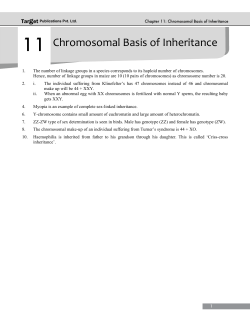
File
Reproduction (CH 5) and Mutations (8.7) Study online at quizlet.com/_1adqrq 3 stages of Interphase Gap 1 (G1), Synthesis (S-phase), Gap 2 (G2) 3 types of asexual reproduction 1. binary fission 2. budding 3. fragmentation 3. 4 stages of cell cycle 1. G1 2. Synthesis 3. G2 4. Mitosis 4. 4 stages of mitosis 1. prophase 2. metaphase 3. anaphase 4. telophase advantages of asexual reproduction - faster than sexual reproduction - works well in a stable environment - do not need a sexual partner 1. 2. 5. 6. anaphase 11. budding a form of asexual reproduction in which a new organism grows out of the body of a parent 12. cancer 13. cell cycle uncontrolled cell division pattern in which all cells grow in size, copy their DNA, and reproduce into new cells sister chromatids are pulled apart to opposite ends of the cell apoptosis programmed cell death asexual reproduction genetically identical offspring from one parent (bacteria, starfish, yeast, hydras) 9. benign tumor harmless tumor 10. binary fission the asexual reproduction that bacteria use to split one cell into two clones 7. 8. 14. centrioles organelles that help during cell division; only found in animal cells 15. centromere holds sister chromatids together 16. chromatid 23. fragmentation a type of asexual reproduction where a single parent breaks into parts that regenerate into whole new individuals 24. frameshift mutation one-half of a duplicated chromosome 17. chromosomes 18. crossing over DNA wrapped tightly around proteins - a mutation that changes the reading frame - most codons after the mutation will code for different amino acids - most of the time the resulting protein is not functional homologous chromosomes exchange bits of DNA during Meiosis I 19. "cyto" 20. cytokinesis 25. G1 stage first stage of growth 26. G2 stage second stage of growth 27. gametes sex cells made in the reproductive organs 28. histones the proteins that help hold chromosomes together cell 29. homologous chromosomes (homologs) chromosomes that have the same types of genes, but they are not identical clones of each other splitting the cell into 2 by dividing the cytoplasm 21. 22. diploid having 2 sets of every chromosome; we have 46 total chromosomes when we are diploid disadvantages of asexual reproduction - very bad in environments that change - there is no genetic diversity (all offspring are clones) - susceptible to being wiped out 30. Interphase - portion of cell cycle in which cells grow and replicate DNA - cells spend a lot of time here in Interphase 31. "kinesis" split malignant tumor cancerous tumor 32. 33. Meiosis 42. 43. 44. # of human chromsomes 23 pairs (46 total) point mutation mutation that affects a single nucleotide prophase cell division that makes 4 haploid daughter cells from 1 diploid parent cell 34. sister chromatids are visible; centrioles have formed; nuclear membrane disappears metaphase 45. silent mutation a mutation that does not change the amino acid. 46. sister chromatids chromosomes line up along the "equator" 35. metastisize when cancer cells break away and travel to different parts of the body thru the bloodstream 36. missense mutation a point mutation in which the amino acid is changed 37. Mitosis process that results in 2 daughter cells that are identical to the parent cell 38. mutation a change in DNA Mutations can be good (rare) when they increase genetic ______________. variation 39. 40. 2 identical chromatids 47. somatic cells 48. stem cells nonsense mutation a mutation that changes a codon to one of the three stop codons, resulting in a shorter and, usually, nonfunctional protein 41. body cells; they use mitosis to reproduce nuclear membrane membrane that surrounds the nucleus and holds in the chromosomes cells that have the ability to become almost any type of cell 49. Synthesis stage DNA is copied 50. telomeres caps on the ends of chromosomes that protect DNA; they get shorter over time, which can lead to DNA damage 51. telophase nuclear membranes form at both ends of the cell 52. Which base of a codon usually gives a "silent mutation"? (1st, 2nd, or 3rd) the 3rd base is usually harmless
© Copyright 2025





















